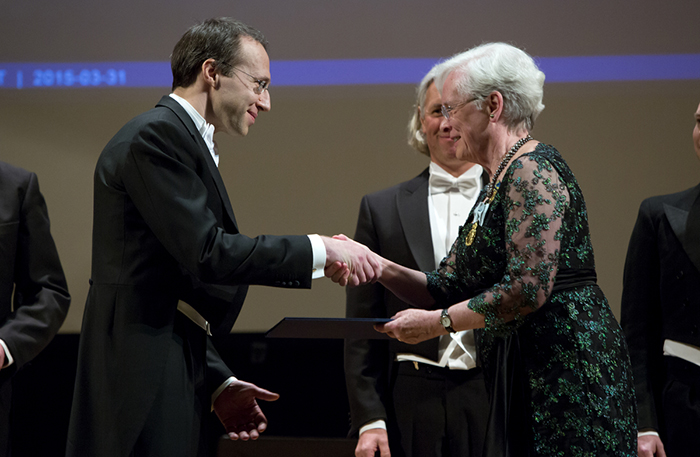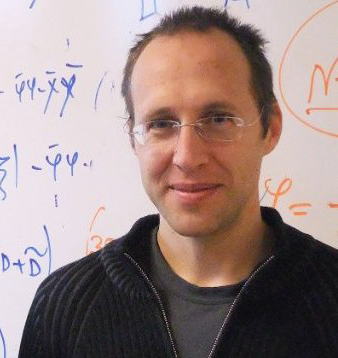Award-winning physicist prizes originality

Egor Babaev, a physics researcher at KTH Royal Institute of Technology, is one of five young researchers who will share SEK 24 million awarded by the Royal Swedish Academy of Sciences (KVA). In awarding the Göran Gustafsson Prize for young researchers, the KVA cited Babaev's "original theoretical research, which has shown entirely new ways to understand complex systems and processes in materials physics."
"This is a big honour for me," says Babaev, who is an associate professor in the Department of Theoretical Physics at KTH. "The prize is given by the KVA, where many accomplished and respected Swedish scientists are involved in the process."

Tell us about your research. What does it involve?
My team and I are working with diverse topics in condensed matter and material physics. I am pleased that the citation mentions 'originality", because I myself value originality and creativity most in work by my peers. In physics one should try not to take for granted, but challenge, even the most basic notions, no matter how well-established they may seem to be. This does not offer the path of least resistance, yet my research group likes to take these kinds of paths. For example, in 2003 I wrote a paper on superconductors with multiple coherence lengths which fall outside the traditional type-1/type-2 classification of superconductors. And, the paper was rejected, not only from high-impact journals but even from regular journals. The initial reaction of the referees was that it is not possible even in principle and should not be published in any form. It took almost three years, appeals, and a number of rewrites to convince referees that the idea is publishable in Physical Review B. In the same journal, other papers of mine were published typically within few months. After that, there were a few years in which no one cited that paper, yet today it is the most downloaded, and one of the most cited, of all my papers. And, seven years after the initial proposal, this research direction was supported by the some of most prestigious grants in Sweden and in the US.
What would be the application of this research?
When we gain a better understanding if the phenomenon of superconductivity, it will inevitably produce new technologies which can change our life. Even today, superconductors are found in MRI scanners at hospitals, electric transmission lines, superconducting motors, current limiters, detectors and sensors. I understand that the world record for fastest manned rail vehicle is held by a superconducting magnetic levitation train. The potential applications are even more exciting: research is being done on using superconductors in medical sensors. One of the key properties of superconductors is that they can form tiny electronic vortices (quantum vortices) which stability is topologically protected. To move such a vortex in a superconductor is, in many respects, much easier than to move a charge in semiconductors. Thus one can in principle build ultra-fast computers where bits are implemented by vortices with clock-wise or counter-clock-wise circulation. In fact, ultra-fast vortex-based prototype computers were built in the mid-1980s. Many ideas are circulating now regarding how quantum computers could be build using superconductors.
A personal question. What do you like about doing research?
As a physicist you can constantly learn new things and understand the world around you better, satisfy your curiosity. There are several aspects of working in the field of superconductivity and superfluidity which I appreciate. The tremendous number of research directions you can take, and research tools you can use, allows you to be as creative as you want. Also whatever complicated direction you take in this field, there is a high probability you will encounter something unexpected and counter-intuitive. The field offers many interesting things to learn, because of contributions of many high creative people: 18 people received Nobel prize for research on superfluidity and superconductivity. Besides that, there are five Nobel laureates who received prizes for other topics but who greatly contributed to our understanding of superfluidity and superconductivity. One very important important factor is that research in superconductivity and superfluidity is deeply connected with experiments. The experimental input is crucial when one deals with the counter-intuitive quantum world. Often discoveries made in this field have interdisciplinary impact. Indeed, even several Nobel prize winners working in high energy physics have explicitly acknowledged that their respective breakthroughs were based on helpful analogies of phenomena observed in superfluidity and superconductivity. One example is last year's prize on Higgs mechanism, whose original work praises Anderson's discussion of the nonrelativistic cousin of this effect in superconductors, as well as Nambu and Jona-Lasinio's work (2008 Nobel prize for the discovery of the mechanism of spontaneous broken symmetry in subatomic physics). Last but not least there is great potential for applications which can change many aspects of our life.
What do you hope to achieve in the near future?
Thanks to great and long-term funding which I have received from the Swedish Research Council's "Outstanding Young Researcher" grant, and now the Göran Gustafsson Prize, I started to assemble a strong group of researchers and students. We have many exciting new ideas which we can now investigate and test. I hope that we will find many answers to our conjectures and resolve some experiment puzzles within next five years. But I also hope that on the way we will discover something which we do not anticipate now. With new PhD students joining the group, our chances for new discoveries will only increase.
Jill Klackenberg
For more information, contact Egor Babaev at babaev @ kth.se
Home page Photo: By Julian Litzel (Jullit31) (Own work) [GFDL (http://www.gnu.org/copyleft/fdl.html) or CC BY-SA 3.0 (http://creativecommons.org/licenses/by-sa/3.0)], via Wikimedia Commons